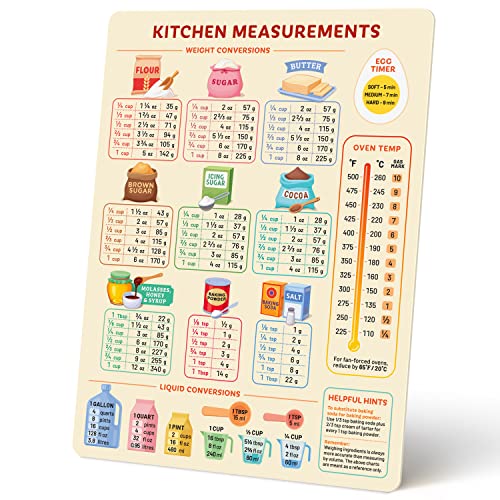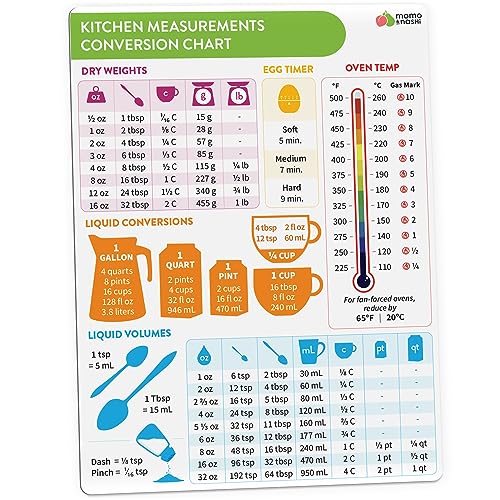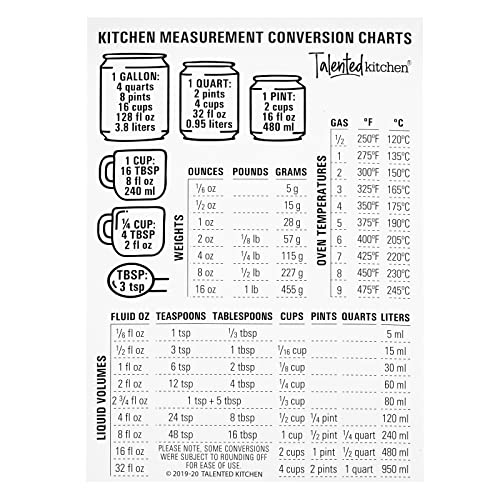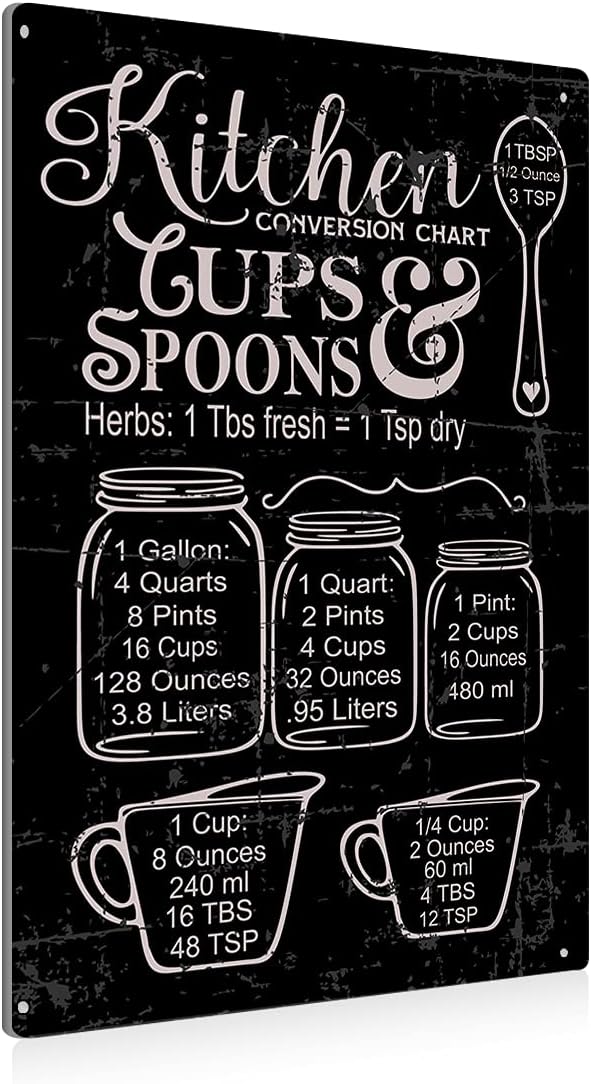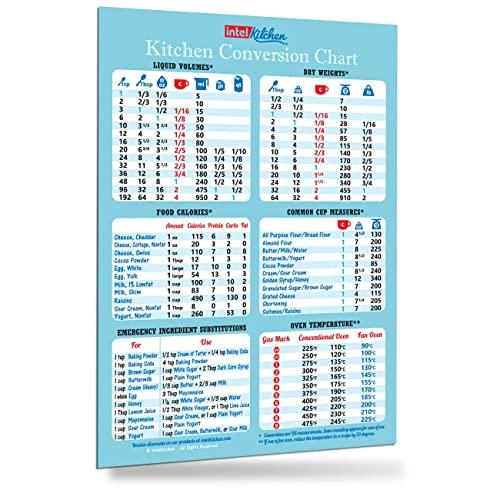- sign in
- Design
- Food
- Pop Culture
- Style
- DIY Classes
The Best Kitchen Conversion Charts of 2024
E-Commerce WriterPublished on February 10, 2024Last updated on July 18, 2024When you're in the kitchen trying to follow a recipe, there's nothing more frustrating than getting stuck on conversions. Whether it's figuring out how many tablespoons are in a cup or converting grams to ounces, it can really throw off your cooking groove. That's where a handy kitchen conversion chart can save the day. It's like having a cheat sheet that quickly gets you back on track, making sure your dishes turn out just right. If you're looking for one that covers all the bases, we're big fans of the Kitchen Conversion Chart Magnet from Levain & Co. It's not only useful but also adds a vintage charm to your kitchen, making it our top pick for cooks and bakers alike. And if you're curious about other options that might fit your style or needs, keep reading to check out more choices below.
The Levain & Co Kitchen Conversion Chart Magnet serves as an efficient, dependable assistant for both seasoned bakers and beginners. With this handy tool, you'll breeze through recipe measure...
read moreImportant Features- Colorful graphics
- Giftable packaging
- Liquid & weight conversions
- Magnetic back
No more fumbling through cookbooks or reaching for your phone while your hands are covered in flour. The Momo & Nashi Kitchen Conversion Chart magnet attaches right to your fridge for easy ac...
read moreImportant Features- Water-resistant
- Strong magnetic backing
- Dry & liquid conversion
- Temperature conversion
If you're tired of the constant googling for unit conversions while cooking, the Talented Kitchen Conversion Chart Magnet is the solution you need. Instead of fumbling around with different apps ...
read moreImportant Features- 5 x 7 inch size
- User-friendly graphics
- Includes metric conversions
- Strong magnetic backing
- Suitable for teaching tools
If you're a fan of baking who also takes pride in home decor, you'll want to consider the Beastzheng Kitchen Conversion Chart for your space. It transforms a bland kitchen wall into a vibrant cen...
read moreImportant Features- Constructed from aluminum
- Durable and long-lasting
- Dimensions: 8 x 12 inches
- Features 4 pre-drilled installation holes
Looking for a useful kitchen tool that simplifies cooking and baking? The intel Kitchen Conversion Chart might just be your new best friend. This handy reference guide effortlessly streamlines yo...
read moreImportant Features- Hands-free daily kitchen reference guide
- Contains 50% more conversion data
- Includes food calories and emergency substitutions
- Simplified common liquid and dry weight conversions
- Waterproof and easy to clean
The Best Kitchen Conversion Charts
The Levain & Co Kitchen Conversion Chart Magnet serves as an efficient, dependable assistant for both seasoned bakers and beginners. With this handy tool, you’ll breeze through recipe measurements with ease, eliminating the time-consuming task of manually converting units. We love the vintage design of the magnet that adds a dash of charm to the kitchen, making it a cute culinary accessory that serves a practical purpose.
In terms of functionality, this kitchen conversion chart has really impressed us by being a quick and easy reference, it proves its worth as a must-have kitchen aid, boosting your baking efficiency. Whether you’re juggling multiple recipes or trying out a new one, you’ll appreciate having this conversion chart at your fingertips. As a bonus, it’s also a great gift option for your baker friends.
Pros- Easy to use
- Convenient for adjusting recipes
- Great for baking education
Cons- Small font size
Most ConvenientMomo & Nashi Kitchen Conversion Chart Magnet
No more fumbling through cookbooks or reaching for your phone while your hands are covered in flour. The Momo & Nashi Kitchen Conversion Chart magnet attaches right to your fridge for easy accessibility, enabling you to convert measurements for weight, liquid, and temperature while cooking. It’s not just a practical kitchen tool but also an attractive piece of decor, enhancing the visual appeal of your kitchen.
This kitchen conversion chart simplifies the process of converting measurements, aiding you in recipe baking like a seasoned professional. We were really impressed by its sturdy magnetic backing that keeps it in place. Rather than being just a kitchen accessory, the kitchen conversion chart takes a proactive role in making your cooking process smoother and more efficient.
Pros- Easily accessible
- Clear, readable design
- Durable material
Cons- Dry weights may be inaccurate
Most AffordableTalented Kitchen Conversion Chart Magnet
If you’re tired of the constant googling for unit conversions while cooking, the Talented Kitchen Conversion Chart Magnet is the solution you need. Instead of fumbling around with different apps and websites, this magnet puts valuable conversion information at your fingertips. Its magnetic backing allows you to secure it on your fridge, turning your appliance into a convenient and user-friendly recipe conversion tool.
This affordable conversion chart excels in design and functionality, featuring both US customary and metric units for precise measurements. It also doubles as a stylish fridge decor with its neat, minimalist design. This magnetic kitchen conversion chart not only streamlines your cooking and baking process but also frees up your time and eliminates the need for guesswork. It’s a must-have tool for both beginner and seasoned home cooks.
Pros- Convenient
- Magnetic, adheres to fridge
- Includes all key kitchen conversions
Cons- Text size may be too small for some
Best Decorative ChartBeastzheng Kitchen Conversion Chart Sign
If you’re a fan of baking who also takes pride in home decor, you’ll want to consider the Beastzheng Kitchen Conversion Chart for your space. It transforms a bland kitchen wall into a vibrant centerpiece with its crisp, clear print quality. Acting as both a stylish wall art piece and a practical conversion chart, it combines functionality with visual appeal.
The kitchen conversion chart is built to endure. It stands as a highly durable sign for high-traffic areas in the home, especially the bustling kitchen. It withstands splatters, spills, and daily use without fading, making it a long-lasting addition to your space. You’ll find yourself turning to this chart regularly, appreciating not only its aesthetic but also how it smoothens your culinary process.
Pros- Crisp and clear print quality
- Lightweight and sturdy metal design
- Versatile for various room decor
Cons- Hanging hardware not included
Most Comprehensiveintel Kitchen Conversion Chart Magnet
Looking for a useful kitchen tool that simplifies cooking and baking? The intel Kitchen Conversion Chart might just be your new best friend. This handy reference guide effortlessly streamlines your culinary process by providing 50% more data, including common cup measurements, ingredient substitutions, food calories, and optimal cooking times and temperatures. It magnetically adheres to your refrigerator, putting crucial cooking information at your fingertips in a snap.
Not only does the kitchen conversion chart offer an extensive range of conversion data, but it also includes bonus content such as ingredient substitution recommendations—a real lifesaver when you’re in the middle of a recipe and realize you’re missing a key ingredient. This chart transforms your cooking experience by offering smooth navigation of recipes and empowering you to try complex dishes with confidence.
Pros- Easy reference for substitutions
- Aids in dietary management
- Convenient magnet for quick access
Cons- Some customers received bent charts
Best Kitchen Conversion Chart: A Buying Guide
Cooking is an art and with the right tools, it can be a delightful experience. One such indispensable tool is a kitchen conversion chart. This guide will assist you in finding the best kitchen conversion chart to match your cooking needs.
Size
First and foremost, consider the size of the kitchen conversion chart. It needs to be large enough to read easily, but it shouldn’t take up too much space in your kitchen. You want it to be visible for quick reference, but not intrusive. Some charts come in the form of fridge magnets, while others can be hung on the wall. Your choice should blend seamlessly into your kitchen layout, enhancing your cooking space conveniently.
Material
The material of the kitchen conversion chart plays a significant part in its durability. Your kitchen environment can be chaotic, with spills and splashes a common occurrence. Therefore, your conversion chart should be made of a material that can resist this chaos. Look for charts made from laminated paper, vinyl, or even metal. These materials can withstand the wear and tear of kitchen activities, keeping your conversion chart in good shape for a long time.
Readability
Your kitchen conversion chart needs to be readable. Imagine being in the middle of a complicated recipe and struggling to decipher the conversion ratios on your chart. You want a conversion chart with clear, easy-to-read fonts and an uncomplicated layout. The measurements should be precise, and the ratios should be easy to understand. The last thing you want is to misread a conversion and ruin your dish.
Units of Measure
A good kitchen conversion chart should provide a variety of units of measure. The chart should cover all the common measurement units used in cooking, such as teaspoons, tablespoons, cups, ounces, and grams. Additionally, it should include conversions for oven temperatures in both Celsius and Fahrenheit. The more comprehensive the chart, the more helpful it will be in your culinary endeavors.
Design and Aesthetics
While functionality is a priority, the design and aesthetics of the kitchen conversion chart should not be overlooked. The chart should complement your kitchen decor. Some charts come in various colors and designs that can add a touch of style to your kitchen. Look for a chart that not only simplifies your cooking process but also adds visual appeal to your kitchen.
Price and Reviews
Before making a purchase, consider the price and reviews of the kitchen conversion chart. The price should correspond with the quality and features of the chart. Don’t just opt for the cheapest option; make sure it meets all your needs. Also, look at customer reviews and ratings to get an idea of the chart’s performance. Reviews from other users can provide valuable insights and help you make an informed decision.
Kitchen Conversion Chart FAQs
Q: How do I use a kitchen conversion chart?A: To use a kitchen conversion chart, first locate the unit of measurement that you want to convert from, and then find the equivalent quantity in the unit you want to convert to. The chart usually has a list of common ingredients for easy reference.
Q: Does a kitchen conversion chart work for all ingredients?A: A kitchen conversion chart works best for liquid and dry ingredients. However, for certain items like chopped fruits, vegetables, or cheese, the measurements can vary. The chart provides an approximate conversion and may not always be 100% accurate.
Q: How do I clean a physical kitchen conversion chart?A: Cleaning depends on the material of the kitchen conversion chart. If it is laminated or made of a wipe-clean material, you can use a damp cloth. Avoid using abrasive cleaners, as they might damage the chart. If it's a paper or card chart, avoid getting it wet.
Q: Can I use a kitchen conversion chart for international recipes?A: Absolutely. A kitchen conversion chart can help convert measurements common in other countries, such as converting grams to ounces for British recipes, or Celsius to Fahrenheit for European recipes.
Q: What should I do if my kitchen conversion chart is not accurate?A: If your kitchen conversion chart isn't accurate, it might be best to invest in a new one. It's important to have accurate measurements, especially when baking, as it can greatly affect the outcome of the recipe.
Q: Do I need a kitchen conversion chart if I have a digital scale?A: While a digital scale is very useful, a conversion chart can still provide value. For example, some recipes may call for 'cups' or 'spoons' of an ingredient, and a conversion chart can quickly help you determine these measurements in a format that the scale can read.
Q: Where is the best place to store my kitchen conversion chart?A: The best place to store your chart is anywhere that's easily visible and accessible while you're cooking. Some people place theirs inside a kitchen cabinet door, on the fridge, or even framed on the kitchen wall.
We may earn a commission if you make a purchase through one of our links. The newsroom or editorial staff was not involved in the creation of this content.Natalie is a graduate from the Ohio State University where she studied English. She edits content about lifestyle and education. In her free time, she enjoys trying new recipes, reading in the park, and exploring her city of Columbus, Ohio.

